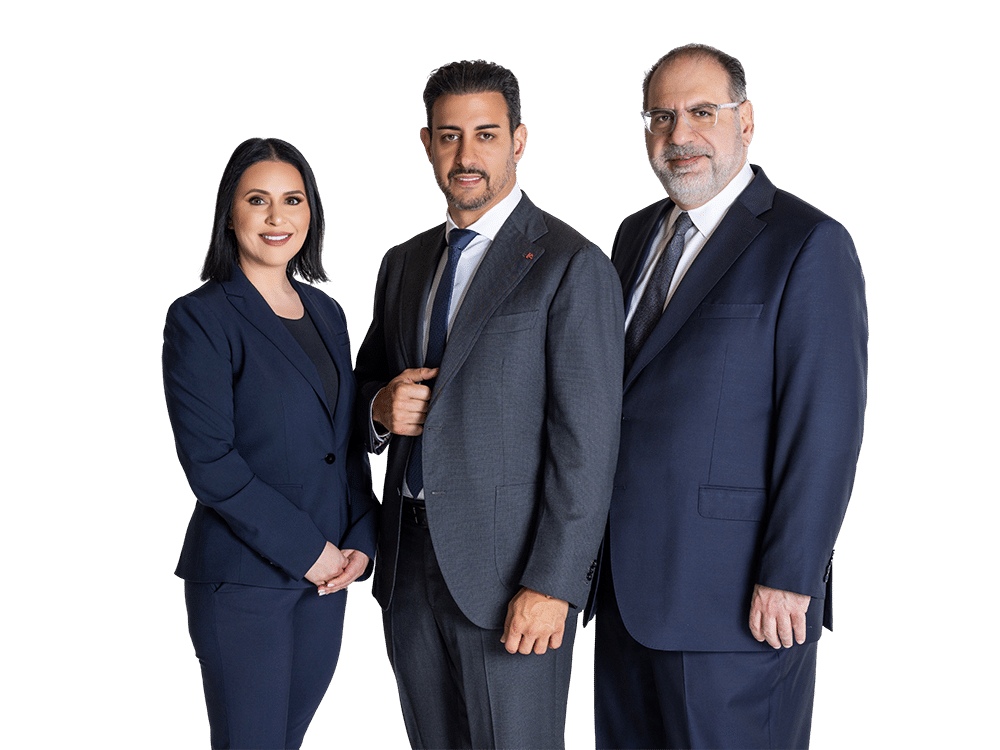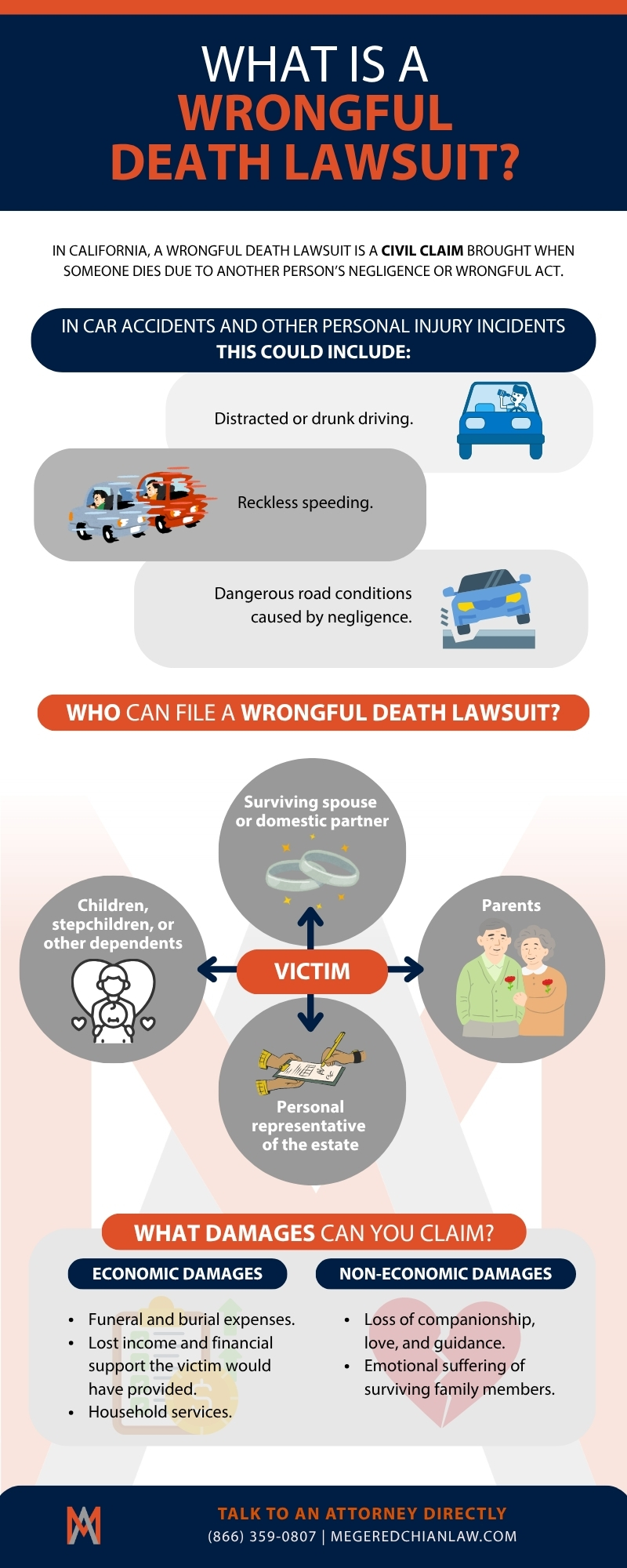In California, a wrongful death claim is a civil lawsuit brought when someone dies as a result of another person’s negligence, recklessness, or intentional misconduct.
These claims are filed by certain surviving family members or the estate of the deceased and are designed to recover compensation for losses resulting from the death—such as funeral costs, loss of financial support, and emotional suffering. A wrongful death action is separate from any criminal charges that may be filed in connection with the death.
While the claim seeks financial compensation, it also plays a critical role in holding the responsible party accountable in civil court.
How to File a Wrongful Death Claim
Filing a wrongful death claim in California involves a series of legal steps designed to help surviving family members seek compensation after the negligent or wrongful death of a loved one. Here’s how the process works:
Confirm Eligibility
Only certain individuals can file a wrongful death claim. It’s essential to confirm that you meet the legal requirements before proceeding.
Hire an Experienced Wrongful Death Attorney
Wrongful death claims can be legally complex and emotionally overwhelming. Skilled wrongful death attorneys can evaluate your case, preserve evidence, identify liable parties, and guide you through each step. Megeredchian Law attorneys offer free consultations and work on a contingency fee basis, meaning you pay nothing unless you win.
Investigate the Death and Gather Evidence
Your legal team will begin a full investigation into the circumstances of the death. This may involve reviewing medical records, accident reports, eyewitness accounts, expert analysis, and surveillance footage. Proving liability is a critical step, especially when multiple parties are involved.
File the Wrongful Death Complaint in Civil Court
Once liability is established, your attorney will draft and file a civil complaint in the appropriate California court. This document outlines your legal claims, the basis for liability, and the compensation you are seeking. Filing must occur within two years of the date of death to comply with the statute of limitations.
Engage in Pre-Trial Procedures
After filing, the case enters the pre-trial phase, which includes discovery (exchanging evidence and witness testimony), mediation, and negotiations with insurance companies. Many wrongful death cases are resolved through settlement before reaching trial, but your attorney will be prepared to go to court if necessary.
Reach Settlement or Proceed to Trial
If a fair settlement is reached, your claim concludes with an agreed-upon financial payout. If not, your case will proceed to trial, where a judge or jury will decide whether the defendant is liable and what damages should be awarded.
Who Can File a Wrongful Death Claim
California law strictly defines who may file a wrongful death claim. The right to bring the claim generally follows a priority order, meaning that certain relatives have precedence over others. Here’s how eligibility is structured:
- Surviving Spouse or Registered Domestic Partner: The highest priority is given to the surviving spouse or registered domestic partner of the deceased. If either exists, they typically lead the claim or are included in the action alongside other qualifying relatives.
- Children of the Decedent: If there is no surviving spouse or domestic partner—or even if there is—biological and legally adopted children of the deceased are next in line to file the claim, often jointly with other eligible parties.
- Grandchildren (if Children Are Deceased): If the decedent’s children are no longer living, their children (the decedent’s grandchildren) may file a wrongful death claim in their place.
- Dependent Minors Living in the Household: Any minor who lived with the deceased for at least 180 days prior to the death and was financially dependent on the decedent may have the right to file. This may include stepchildren or other minors with no blood relation.
- Other Heirs Under California Intestate Succession Law: If none of the above parties exist, the right to file may extend to other individuals who would inherit under California’s intestacy laws—such as parents, siblings, or other blood relatives.
- Personal Representative of the Estate: A personal representative of the decedent’s estate may file the wrongful death claim on behalf of all eligible survivors. This often occurs when multiple heirs exist or when coordination among them is needed.
Can a Sibling Make a Wrongful Death Claim in California?
This is a particular case worth mentioning. In California, a sibling may be allowed to pursue a wrongful death claim, but only under specific legal conditions.
State law prioritizes certain close family members—such as a spouse, domestic partner, children, and grandchildren—as the first individuals eligible to bring a claim. If none of those relatives survive the decedent, then siblings may be permitted to file, but only if they are next in line to inherit under California’s intestate succession rules.
Contrary to popular belief, siblings do not have an automatic right to file a wrongful death lawsuit, and they generally cannot do so if higher-priority heirs exist. Financial dependency is not a requirement for siblings to qualify, unless they are filing under a separate provision intended for non-relatives or minors.
What Is a California Wrongful Death Lawsuit, and How Is It Different from a Claim?
A California wrongful death lawsuit is a formal legal action filed in civil court by eligible family members or a personal representative after someone dies due to another party’s negligence, recklessness, or intentional act. It seeks financial compensation for the survivors’ losses—such as funeral expenses, lost income, and loss of companionship.
While the terms “claim” and “lawsuit” are often used interchangeably, there is a key difference.
A wrongful death claim typically refers to the broader process of pursuing compensation, which often begins with negotiations or a demand letter to an insurance company. If the claim cannot be resolved through settlement, it may escalate into a wrongful death lawsuit, where the matter is litigated in court.
In short, a claim is the initial attempt to resolve the issue outside of court, while a lawsuit is the formal legal action taken if no settlement is reached.
How Difficult are Wrongful Death Lawsuits in California?
Wrongful death lawsuits in California can be challenging, but not impossible to win.
While no wrongful death attorney in California can promise a guaranteed outcome, recent data and case trends suggest that plaintiffs continue to win around 50–60% of wrongful death trials in California, based on aggregated legal reporting and court outcomes from 2023 through mid-2025. That success rate reflects the importance of clearly proving liability. If the responsible party’s fault is well-supported by evidence, your chances of success increase significantly.
Several key factors affect the complexity and outcome of these cases. First, the statute of limitations in California is two years from the date of death (Code of Civil Procedure § 335.1), so timing is critical. Strong evidence—including medical documentation, expert testimony, and witness statements—is essential. Additionally, factors such as the value and type of damages sought, the defendant’s legal resources, and your attorney’s trial experience all play a role.
Most wrongful death claims in California still settle out of court, offering families a path to financial recovery without the uncertainty of a jury trial. That’s why working with experienced wrongful death attorneys is one of the most important decisions you can make when pursuing justice.
What to Expect in a Wrongful Death Lawsuit Consultation
A wrongful death consultation is a confidential, no-obligation meeting with a qualified attorney to review the circumstances of a person’s death and determine whether a civil lawsuit is appropriate. In California, these claims arise when someone dies due to another party’s negligence, recklessness, or intentional act. At Megeredchian Law, our wrongful death attorneys offer free consultations to help families understand their rights, options, and next steps without any upfront cost.
During the consultation, the attorney will:
- Evaluate the facts of your case by reviewing any available evidence, such as medical records, death certificates, police or accident reports, and witness statements. In some cases, they may recommend expert input or additional investigation.
- Explain your legal rights, including who is eligible to file, what damages can be recovered (funeral expenses, loss of income, emotional losses), and whether a survival action may also apply.
- Discuss deadlines, especially the two-year statute of limitations.
- Provide recommendations on how to move forward and whether your case is viable.
- Explain the fee structure, which is typically on a contingency basis—meaning you pay no attorney fees unless the case is successful.
This consultation is entirely confidential and non-binding—there’s no obligation to hire us. It’s your opportunity to ask questions, get clarity, and decide whether pursuing legal action is the right path for your family.

 Call Us:
Call Us: 


